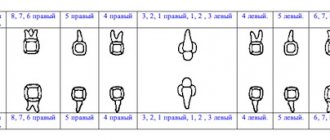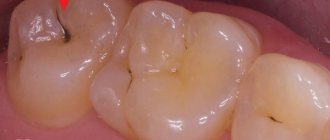Treatment of caries of children's primary teeth
Caries of primary chewing and front teeth has long been treated without the slightest pain.
New modern techniques have reduced the use of drills and drilling to a minimum, and timely scheduled examinations make it possible to detect the disease at a very early stage. The doctors at Aza&Buka Pediatric Dentistry who work with young patients are distinguished by an amazing sense of tact and constant positivity. Knowledge of the child’s psychology allows doctors to build communication and dialogue in such a way that children sit in the dental chair without the slightest fear. If the child already has some dental phobia, then adaptation techniques can solve the problem.
Caries on baby teeth in children is treated using the following technologies:
Asymmetry in the face, smile, bite
If you notice any signs of asymmetry in a child, this is a reason to immediately consult a doctor. At any age of the child - as soon as noticed. Of course, all people are naturally asymmetrical. But natural asymmetry is not visible to the eye and does not attract attention. What you need to pay attention to in terms of asymmetry: • displacement of the chin to the side • the smile is not symmetrical • the central lines of the upper and lower jaws do not coincide (with each other and with the central line of the face). The orthodontist will be able to conduct an examination and prescribe the necessary treatment or examination to identify the causes of asymmetry.
Classic filling
requires a special approach when treating young patients, since the doctor has to use dental equipment, which often causes fear in children.
Aza&Buka dentistry uses both traditional and modern methods of treating caries of primary teeth, selecting a method taking into account the age of the child and the degree of neglect of the process.
Plaksina Margarita
“Modern parents are great! They themselves are not afraid of dentists, and children are taught the same thing: to come on time for preventive appointments and examinations. In such cases, doctors can intercept the very beginning of a cavity infection and prevent tooth decay without drilling.”
Where can you get your child’s teeth treated without fear?
It is good if the child is observed by one dentist throughout the entire period from early childhood to 18 years.
Firstly, the baby will always see a familiar doctor in front of him and will not be afraid, cry or worry. And secondly, a specialist who monitors the child’s dental health from an early age knows all its features and will notice the problem at the very beginning of its development. It is important not only how teeth are treated for children 2 years of age and older, but also where it is done. All establishments in the city are divided into three large groups:
- State clinics. This option is best left for last resort. Why? There are long queues, many capricious children, nervous parents and doctors who are given a limited time for an appointment and not a minute more. At the same time, dental equipment, as a rule, remains from the last century, and no one has heard of good medicines and fillings.
- Special children's rooms in high-profile private hospitals. If you are looking for a good combination of price and quality, then this option is suitable. There is all the necessary equipment, modern medications designed specifically for baby teeth, and a specialist doctor whose competence includes only the treatment of children’s first teeth will work with a boy or girl.
- Private specialized children's dental clinics. They are intended exclusively for small patients. Here everything is done for their coziness and comfort, there are no long queues, all patients come only at the appointed time, and you can make an appointment for a convenient day for an appointment. All equipment, instruments and medications are intended exclusively for children's teeth. Well, the quality of service always remains at the highest level. The only negative is the high prices, and even a simple consultation will be paid.
Which treatment methods to choose and where exactly the baby should be treated is, of course, decided by the parents. You should not go to extremes and should choose according to your financial capabilities. After all, even in a free city clinic you can get access to competent and experienced specialists. The only thing that remains is to read the reviews and ask your friends who and how they treat the teeth of children aged 4 years. If possible, immediately contact a paid pediatric dentistry.
Milk caries: initial, superficial, medium, deep
Doctors distinguish 4 stages of the formation of carious areas:
- Initial caries - tooth enamel becomes covered with small spots of white or yellowish tint.
- Superficial caries - the enamel begins to deteriorate, small and light cavities are observed.
- Medium – the layer of tooth enamel is destroyed, the affected area extends deeper.
- Deep - the layers of dentin have already been affected, and the pulp is under threat.
It is necessary to treat milk caries at the very first stage, although it does not cause any discomfort in the child. The fact is that the enamel and crowns of temporary teeth are subject to rapid destruction, and the development of caries occurs very quickly. Deep caries often provokes irreversible changes, which leads to premature removal of the baby tooth.
Rodikova Tatyana
“Medium and deep caries most often occurs in schoolchildren, almost teenagers. Children brush their teeth poorly, and they talk about problems only when caries has already affected the pulp. In this case, the treatment turns out to be more unpleasant, since removal of the pulp cannot be avoided. That’s why I always ask parents to carefully monitor their teenagers’ hygiene and bring them to appointments on time.”
Reverse overlap of incisors
Reverse incisor overlap is when the lower teeth protrude forward). Reverse overlap blocks the normal growth of the upper jaw in length. The most optimal time to correct such a bite is from the age of 5-6 years. At this age, the incisors of the upper and lower jaws erupt and this is the most favorable time to begin orthodontic correction. If you notice a reverse overlap in a child at a later age, it is also important to contact an orthodontist in order to rid the upper jaw of the blockage as quickly as possible and give it the opportunity to continue to grow actively.
Reasons for the development of caries in temporary teeth
When visiting a dentist, parents are invariably interested in the reasons for the appearance of such an unpleasant disease. This is important because it helps prevent damage to new teeth. Sometimes it is enough to change eating habits and hygiene patterns so that the child forgets about fillings for a long time, and only comes to the dentist for examinations.
Causes of caries:
- Poor or insufficient oral hygiene. Food remains in the interdental space and on the enamel are an excellent environment for the development of carious bacteria.
- An unbalanced diet with a preponderance of sweets and carbohydrates - during the fermentation of simple carbohydrates, acids are formed that provoke the destruction of enamel.
- The lack of solid foods in the menu leads to a decrease in the frequency of chewing, reduces salivation and becomes a common cause of caries of primary teeth in young children.
- Long-term use of nipples, including on bottles and sippy cups, increases the risk of developing single or multiple bottle caries of the anterior milk teeth in children.
- Rickets is a pathology that provokes the destruction of dental tissues.
- Genetic predisposition of the child.
- Problems with bite – various anomalies in the formation of the dentition.
- Decreased natural immunity due to frequent acute respiratory viral infections, chronic diseases, and taking various medications.
- Damage to tooth germs in the prenatal period - due to maternal illness or neglect of health in the first trimester.
At what age can you treat
There are no strict age limits regarding the age at which children can have their teeth treated. Indications for visiting a doctor are:
- carious foci of infection in the oral cavity;
- inflammation of periodontal tissues;
- baby has bad breath;
- enamel fluorosis.
What happens if dental problems are not treated? A chronic source of infection can lead to premature tooth loss and other health problems - pharyngitis, laryngitis, disruption of the functioning of the intestines and stomach. Children with untreated caries become vulnerable to viral, fungal and bacterial pathogens due to the fact that their immunity cannot work at full strength.
Caries can spread not only to enamel and dentin, but also to the rudiments of permanent elements, provoking the development of periodontitis. One of the serious complications of dental disease is pulpitis, accompanied by acute pain.
Pulpitis has several stages of progression, and the most complex of them lead to complete destruction of the tooth and involvement of the neurovascular bundle of the unit in the pathological process. An infection through the bloodstream can spread throughout the body and cause a malfunction of the respiratory system and heart.
Untimely loss of dentition elements leads to improper chewing of food due to unevenly distributed load between different parts of the jaw. Insufficiently processed and crushed food is poorly absorbed by the gastrointestinal tract. Therefore, children should be shown to dentists at the moment when they show the first signs of dental disease, regardless of age.
How to prepare for the sedation procedure?
It is necessary to strictly adhere to the recommendations given by the doctor, namely:
Before performing drug sedation, it is necessary to do a general blood test, coagulogram, ECG, biochemical blood test, tests for HIV, HCV, HbsAg, Rw. These studies are required for the safety of the patient himself. General preparation for the procedure is usually carried out directly in the dental clinic itself. Patients are advised to refrain from eating and drinking 4 hours before the procedure.
The doctor should be aware of whether the child has respiratory problems, in particular whether he has difficulty breathing through his nose. In the case of such diseases, the sedation procedure loses its effectiveness to some extent. Be sure to tell the dentist what medications your child took on the day of the clinic visit.
Differences between sedation and general anesthesia
1) The occurrence of coughing, swallowing and other reflexes is excluded, which in turn allows for complete dental safety.
2) The dentist can fully control the patient’s condition, since he is conscious throughout the entire procedure. Another advantage of the action of sedatives is the fact that a person under its influence can be taken out of a state of superficial sleep at any time.
3) The patient is in a relaxed state and can communicate with the doctor.
Very often, due to anxiety, a person cannot clearly formulate his problem, and the patient’s internal tension can complicate treatment. Sedation makes it possible to relieve emotional stress without causing harm to the body. Also, when a person experiences psychological stress, hemodynamic changes occur. High blood pressure and rapid heartbeat force the attending physician to make certain changes to the given treatment regimen.
Benefits of using sedation in children
Therefore, we can say with confidence that the use of sedation has undeniable advantages. Among the advantages of the method are the following:
- The use of ZAX (nitrous oxide - oxygen sedation) makes dental treatment painless;
- The child does not experience psychological discomfort in the doctor’s office: in a state of sedative anesthesia, he does not smell unpleasant odors, does not hear the frightening sound of a drill, and does not distinguish between medical instruments;
- The use of ZAX removes tactile sensitivity, so the baby will not be frightened by vibrations, pressure, compression, etc., made by the doctor;
- The doctor is able to provide full treatment, because his access to the patient is no longer hampered. Now the dentist has enough time to apply the most effective modern treatment methods. He can also use any preparations, even those that harden for a long time;
- The risk of complications after dental treatment is reduced.
The use of sedation has ushered in a new era in pediatric dentistry. After all, doctors now have the opportunity to use modern composite materials for treatment. And they are more durable, hygienic and aesthetically pleasing compared to those previously used. Until recently, composite materials were not used for the reason that their placement requires careful drying of the tooth. The doctor must also wait a long time for the material and fixing glue to harden. Now he has the necessary time reserve.
When should caries be treated?
There are a number of factors that indicate the need for treatment of caries in children, among them the following:
- the presence of an infection that provokes chronic exacerbation of various diseases;
- If caries is not treated at the first stage, the child may lose a tooth, and this can cause problems with chewing. The gastrointestinal tract becomes more vulnerable;
- If baby teeth are in poor condition, then the rudiments of permanent teeth may die.
Parents should be aware that every effort should be made to ensure that all affected primary teeth are saved.
Types of sedation in pediatric dentistry
Sedation for children has a number of features, since not all methods and drugs are suitable for the child’s body.
- Inhalation method (nitrous oxide).
Nitrous oxide sedation is a very common technique in pediatric dentistry. There are several reasons for this. First, nitrous oxide is safe and can be used even on children under 5 years of age. Secondly, dental treatment with gas for children does not require a special license for the use of psychotropic substances. Nitrogen has a minimal effect on the body's systems, and the child recovers very quickly after the procedure. On the other hand, expert reviews of this method are mixed. Many people consider nitrous oxide not the best means for sedation, and sometimes individual intolerance occurs. Dental treatment for children with nitrous oxide cannot last long: the duration of action of laughing gas is very limited. - Oral method.
The effect of sedation is achieved by oral administration of drugs from the benzodiazepine group (Valium, diazepam and similar drugs). This type of sedation is not recommended for children under 5 years of age, and the dosage must be calculated very accurately. - Intravenous method.
The most powerful type of sedation that causes significant depression of consciousness. The drugs are given through a vein, and the patient may require an oxygen mask to maintain breathing. This type of sedation is not given to children.
How is dental treatment performed for children under sedation?
Specific preparation measures are selected depending on the type of sedation, but the preparatory stage cannot be avoided. This is especially true for deep sedation, when it is necessary to take blood tests and determine possible allergic reactions to drugs. Before the procedure, you need to completely give up smoking and alcohol (although this requirement is not so important for a child), and also not eat food 8-10 hours before treatment. During inhalation sedation using nitrous oxide, a light breakfast is possible. After all the necessary preparatory measures have been taken, the entire treatment process is divided into four stages:
- final examination of the oral cavity;
- introduction of a sedative into the body;
- anesthesia;
- treatment.
Treatment of baby teeth and tooth extraction usually does not take much time. The more extensive the treatment, the longer the sedation should last. In some cases, treatment is divided into two stages.
Superficial sedation does not require additional measures to emerge from drug-induced sleep. Deep sedation often involves the use of special antidotes.
How to choose a doctor for your child
A child's first visit to the dentist is a very important event that should be taken very seriously. It is imperative to find a doctor who gets along well with children and to whom the child will go with great pleasure. This will determine whether he will have a fear of dentists in the future.
It is recommended that you spare no expense for the first time and take your child to a paid clinic . In such institutions, treatment is accompanied by a friendly attitude from the staff; children are often shown cartoons and given toys to play with.
Sedation scheme
The patient puts on a mask, and 100% oxygen first enters his lungs. The oxygen mass is supplied at a speed of 4-6 liters per minute. Nitrogen is gradually mixed with oxygen. Its content is increased to 30%. When the proportions of nitrogen and oxygen are brought to a ratio of 30 to 70, respectively, the moment comes favorable for starting treatment. However, it should be noted that the concentration of nitrous oxide may vary depending on the individual patient. It is important to achieve the desired effect, and it, in turn, can occur with a different ratio of nitrogen and oxygen. Individual indicators are recorded in the patient's record.
The blood is saturated with gas in about 5-7 minutes. Nitrous oxide is completely dissolved in blood serum and is not biotransformed in any way. As soon as the supply of ZAX stops, the process of removing gas from the lungs begins. The gas is removed completely unchanged.
ZAX differs from other sedatives in that the sedative effect occurs very quickly, and the trace effect is completely absent. This is caused by nonspecific depression of the central nervous system.
Sedation manifests itself as follows: a comfortable and relaxed state; good, elevated mood; movements are inhibited; deep breathing; motor activity of the eyes is reduced; sound perception is dull; resistance is reduced.
If you plan to undergo a particularly painful procedure, you can temporarily increase the concentration of nitrous oxide to 50% (acceptable limit is 70%). Nitrous oxide has an analgesic effect, and also enhances the effect of local anesthetics. If the child is suddenly frightened and painful sensations begin to “reach” him, manipulation with nitrous oxide will quickly calm the baby down and treatment can be continued.
Thus, the use of ZAX makes it possible to carry out treatment of any complexity in just one visit.
As for removing the patient from the state of sedation, it occurs smoothly and consists of supplying 100% oxygen for 5-10 minutes. At this time, the doctor communicates with the child, trying to reinforce his positive impressions of visiting the dental office.
In general, the successful use of ZAX is impossible without the competent use of behavior management techniques. Trying on a mask by a child should be done in a playful way so that the child has time to relax before the onset of sedation. The doctor calms the child by telling him about the condition he will soon find himself in. You cannot force a mask on, as this may cast doubt on the success of the procedure.











